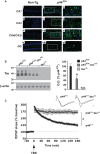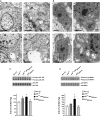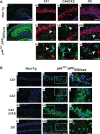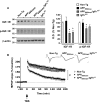Altered longevity-assurance activity of p53:p44 in the mouse causes memory loss, neurodegeneration and premature death
- PMID: 20409077
- PMCID: PMC2848983
- DOI: 10.1111/j.1474-9726.2010.00547.x
Altered longevity-assurance activity of p53:p44 in the mouse causes memory loss, neurodegeneration and premature death
Abstract
The longevity-assurance activity of the tumor suppressor p53 depends on the levels of Delta40p53 (p44), a short and naturally occurring isoform of the p53 gene. As such, increased dosage of p44 in the mouse leads to accelerated aging and short lifespan. Here we show that mice homozygous for a transgene encoding p44 (p44(+/+)) display cognitive decline and synaptic impairment early in life. The synaptic deficits are attributed to hyperactivation of insulin-like growth factor 1 receptor (IGF-1R) signaling and altered metabolism of the microtubule-binding protein tau. In fact, they were rescued by either Igf1r or Mapt haploinsufficiency. When expressing a human or a 'humanized' form of the amyloid precursor protein (APP), p44(+/+) animals developed a selective degeneration of memory-forming and -retrieving areas of the brain, and died prematurely. Mechanistically, the neurodegeneration was caused by both paraptosis- and autophagy-like cell deaths. These results indicate that altered longevity-assurance activity of p53:p44 causes memory loss and neurodegeneration by affecting IGF-1R signaling. Importantly, Igf1r haploinsufficiency was also able to correct the synaptic deficits of APP(695/swe) mice, a model of Alzheimer's disease.
Figures










Similar articles
-
P44, the 'longevity-assurance' isoform of P53, regulates tau phosphorylation and is activated in an age-dependent fashion.Aging Cell. 2014 Jun;13(3):449-56. doi: 10.1111/acel.12192. Epub 2014 Feb 25. Aging Cell. 2014. PMID: 24341977 Free PMC article.
-
The amyloid precursor protein (APP) intracellular domain regulates translation of p44, a short isoform of p53, through an IRES-dependent mechanism.Neurobiol Aging. 2015 Oct;36(10):2725-36. doi: 10.1016/j.neurobiolaging.2015.06.021. Epub 2015 Jun 21. Neurobiol Aging. 2015. PMID: 26174856 Free PMC article.
-
Modulation of mammalian life span by the short isoform of p53.Genes Dev. 2004 Feb 1;18(3):306-19. doi: 10.1101/gad.1162404. Genes Dev. 2004. PMID: 14871929 Free PMC article.
-
The molecular bases of Alzheimer's disease and other neurodegenerative disorders.Arch Med Res. 2001 Sep-Oct;32(5):367-81. doi: 10.1016/s0188-4409(01)00316-2. Arch Med Res. 2001. PMID: 11578751 Review.
-
DeltaNp53 or p44: priming the p53 pump.Int J Biochem Cell Biol. 2005 May;37(5):913-9. doi: 10.1016/j.biocel.2004.11.014. Epub 2005 Jan 11. Int J Biochem Cell Biol. 2005. PMID: 15743665 Review.
Cited by
-
p53, ROS and senescence in the control of aging.Aging (Albany NY). 2010 Aug;2(8):471-4. doi: 10.18632/aging.100189. Aging (Albany NY). 2010. PMID: 20729567 Free PMC article. Review.
-
Melatonin: Regulation of Biomolecular Condensates in Neurodegenerative Disorders.Antioxidants (Basel). 2021 Sep 17;10(9):1483. doi: 10.3390/antiox10091483. Antioxidants (Basel). 2021. PMID: 34573116 Free PMC article. Review.
-
The emerging role of alternative splicing in senescence and aging.Aging Cell. 2017 Oct;16(5):918-933. doi: 10.1111/acel.12646. Epub 2017 Jul 13. Aging Cell. 2017. PMID: 28703423 Free PMC article. Review.
-
p53: Multiple Facets of a Rubik's Cube.Annu Rev Cancer Biol. 2017 Mar;1:185-201. doi: 10.1146/annurev-cancerbio-050216-121926. Epub 2016 Oct 17. Annu Rev Cancer Biol. 2017. PMID: 30775651 Free PMC article.
-
Maternal transmission of an Igf2r domain 11: IGF2 binding mutant allele (Igf2rI1565A) results in partial lethality, overgrowth and intestinal adenoma progression.Sci Rep. 2019 Aug 6;9(1):11388. doi: 10.1038/s41598-019-47827-9. Sci Rep. 2019. PMID: 31388182 Free PMC article.
References
-
- Auer T, Barsi P, Bone B, Angyalosi A, Aradi M, Szalay C, Horvath RA, Kovacs N, Kotek G, Fogarasi A, Komoly S, Janszky I, Schwarcz A, Janszky J. History of simple febrile seizures is associated with hippocampal abnormalities in adults. Epilepsia. 2008;49:1562–1569. - PubMed
-
- Bancher C, Brunner C, Lassmann H, Budka H, Jellinger K, Wiche G, Seitelberger F, Grundke-Iqbal I, Iqbal K, Wisniewski HM. Accumulation of abnormally phosphorylated tau precedes the formation of neurofibrillary tangles in Alzheimer’s disease. Brain Res. 1989;477:90–99. - PubMed
-
- Borchelt DR, Thinakaran G, Eckman CB, Lee MK, Davenport F, Ratovitsky T, Prada CM, Kim G, Seekins S, Yager D, Slunt HH, Wang R, Seeger M, Levey AI, Gandy SE, Copeland NG, Jenkins NA, Price DL, Younkin SG, Sisodia SS. Familial Alzheimer’s disease-linked presenilin 1 variants elevate Abeta1-42/1-40 ratio in vitro and in vivo. Neuron. 1996;17:1005–1013. - PubMed
Publication types
MeSH terms
Substances
Grants and funding
LinkOut - more resources
Full Text Sources
Other Literature Sources
Medical
Molecular Biology Databases
Research Materials
Miscellaneous

